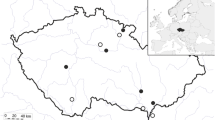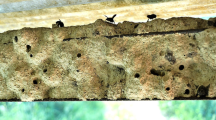Abstract
Sceliphron caementarium and Sceliphron curvatum are non-native species in Europe with former distributions in North America and Asia, respectively. Both species create nests of mud that are usually located inside, on the surface of, or near buildings. Though both species have been studied many times, knowledge on their nesting biology is based on a few studies with small numbers of non-analysed observational data. By collecting information on 123 S. caementarium nests, 341 S. curvatum nests, and 75 nests of the most widespread native species, Sceliphron destillatorium, the nesting place preferences of the wasps were evaluated. The three species do not differ in their nest placements within settlements, in the sizes of the settlements where they nest, or in their nesting locations, and they differ only slightly in the heights of their nests above the ground. The main difference is that S. curvatum nests are usually hidden inside buildings, while the other two species mostly create nests on the surfaces of buildings. Thus, S. curvatum could negatively affect its native relatives due to its high population density and competition for prey, but not due to the competition for nesting sites. Neither non-native species represents any threat to crops or landscapes; the species have only limited negative effects, such as building nests in or on peoples’ houses, carrying mud and spiders to these locations, and annoying people with their loud buzzing during nest building and provisioning. They are both regarded to represent minor threat according to SEICAT classification.
Implications for insect conservation
Both two non-native species are only very little harmful for the native species and probably also for other species of bees and wasps with similar nesting biology. Their harmfulness is much lower than that of other well known invasive insects (Harmonia axyridis and Vespa velutina for example).





Similar content being viewed by others
References
Bacher S, Blackburn TM, Essl F, Genovesi P, Heikkilä J, Jeschke JM, Jones G et al (2017) Socio-economic impact classification of alien taxa (SEICAT). Methods Ecol Evol 9:159–168. https://doi.org/10.1111/2041-210X.12844
Barrera-Medina R, Garcete-Barrett B (2008) Sceliphron curvatum (Smith, 1870) una nueva especie de Sphecidae (Hymenoptera) introducida en Chile. Rev Chil Entomol 34:69–72
Barrera-Medina R, Sepúlveda-Osorio J (2014) Primer reporte de Sceliphron caementarium (Drury, 1773) (Hymenoptera: Sphecidae) para Chile. Bol Soc Entomol Aragonesa 55:295–297
Basil-Edwardes S (1921) On the habits of a Sceliphron wasp (S. deforme). J Bombay Nat Hist Soc 28:293–297
Berland L (1946) Capture enigmatique d’une guepe americaine a Versailles. L’entomologiste 2:227–228
Bitsch J (2010) Compléments au volume 2 des Hyménoptères Sphecidae d’Europe occidentale (Faune de France 82). Bul Soc Entomol France 115:99–136
Bogusch P, Macek J (2005) Sceliphron caementarium (Drury, 1773) in the Czech Republic in 1942—first record from Europe? Linzer Biol Beitr 37:1071–1075
Bogusch P, Hlaváčková L, Šilhán K, Horsák M (2020) Long-term changes of steppe-associated wild bees differ between shell-nesting and ground-nesting species. J Ins Conserv 24:513–523. https://doi.org/10.1007/s10841-020-00232-4
Bohart RM, Menke AS (1976) Sphecid wasps of the world: a generic revision. University of California Press, Berkeley, Los Angeles
Brown PMJ, Roy HE (2017) Native ladybird decline caused by the invasive harlequin ladybird Harmonia axyridis: evidence from a long-term field study. Ins Conserv Diver 11:230–239. https://doi.org/10.1111/icad.12266
Campadelli G, Pagliano G, Scaramozzino PL, Strumia F (1999) Parassitoidi e inquilini di Sceliphron caementarium (Drury, 1773) (Hymenoptera: Sphecidae) in Romagna. Bol Mus Reg Sci Nat Torino 16:225–240
Carvalho J, Hipólito D, Santarém F, Martins R, Gomes A, Carmo P et al (2020) Patterns of Vespa velutina invasion in Portugal using crowdsourced data. Ins Conserv Diver 13:501–507. https://doi.org/10.1111/icad.12418
Cassar T, Mifsud D (2020) The introduction and establishment of Sceliphron caementarium (Drury, 1773) (Hymenoptera, Sphecidae) in Malta (Central Mediterranean). J Hym Res 79:163–168. https://doi.org/10.3897/jhr.79.58659
Ćetković A, Radović I, Đorović LJ (2004) Further evidence of the Asian mud-daubing wasps in Europe (Hymenoptera: Sphecidae). Entomol Sci 7:225–229. https://doi.org/10.1111/j.1479-8298.2004.00067.x
Ćetković A, Mokrousov MV, Plećaš M, Bogusch P, Antić D, Đorović-Jovanović L, Krpo-Ćetković J, Karaman M (2011) Status of the potentially invasive Asian species Sceliphron deforme in Europe, and an update on the distribution of S. curvatum (Hymenoptera: Sphecidae). Acta Entomol Serbica 16:91–114
Chatenoud L, Polidori C, Federici M, Licciardi V, Andrietti F (2012) Mud-ball construction by Sceliphron mud-dauber wasps (Hymenoptera: Sphecidae): a comparative ethological study. Zool Stud 51:937–945
Compagnucci LA, Roig-Alsina A (2008) Sceliphron curvatum, una nueva avispa invasora en la Argentina (Hymenoptera: Sphecidae). Rev Soc Entomol Argentina 67:63–68
Danforth BN, Minckley RL, Neff JL, Fawcett F (2019) The solitary bees: biology, evolution, conservation. Princeton University Press, Princeton
Elgar MA, Jebb M (1999) Nest provisioning in the mud-dauber wasp Sceliphron laetum (F. Smith): body mass and taxa specific prey selection. Behaviour 136(2):147–159. https://doi.org/10.1163/156853999501252
Fallahzadeh M, Ostovan H, Saghaei N (2009) A contribution to the fauna of Sphecidae and Crabronidae (Hymenoptera) in Fars province. Iran Plant Protect J 1:234–248
Fateryga AV, Kovblyuk MM (2014) Nesting ecology of the wasp Sceliphron destillatorium (Illiger, 1807) (Hymenoptera, Sphecidae) in the Crimea. Entomol Rev 94:330–336. https://doi.org/10.1134/S001387381403004X
Gepp J (1995) Die orientalische Mauerwespe Sceliphron curvatum (Smith, 1870): Biologie und Ausbreitungsgeschichte in ostoesterreich (Hymenoptera, Sphecidae). Stapfia 37:153–166
Gepp J (2003) Verdrängt die eingeschleppte Mauerwespe Sceliphron curvatum autochthone Hymenopteren im Sudosten Österreichs? Entomol Austriaca 8:18
Gepp J, Bregant E (1986) Zur Biologie der synanthropen, in Europa eingeschleppten Orientalischen Mauerwespe Sceliphron (Prosceliphron) curvatum (Smith, 1870) (Hymenoptera: Sphecidae). Mitt Naturwis Verein Steiermark 116:221–240
Gogala A (1995) Two non-European species of diggerwasps recorded also in Slovenia (Hymenoptera: Sphecidae). Acta Entomol Slovenica 3:73–75
Hejda R, Farkač J, Chobot K (2017) Červený seznam ohrožených druhů České republiky. Bezobratlí. Red list of invertebrates of the Czech Republic. Příroda 36:1–612
Heneberg P, Bogusch P, Řezáč M (2018) Numerous drift sand “specialists” among bees and wasps (Hymenoptera: Aculeata) nest in wetlands that spontaneously form de novo in arable fields. Ecol Eng 117:133–139. https://doi.org/10.1016/j.ecoleng.2018.04.007
Honek A, Martinkova Z, Roy HE, Dixon AFG, Skuhrovec J, Pekár S, Brabec M (2018) Differences in the phenology of Harmonia axyridis (Coleoptera: Coccinellidae) and native coccinellids in Central Europe. Environ Ent 48:80–87. https://doi.org/10.1093/ee/nvy173
Hua L (2006) Superfamily Apoidea (Sphecoidea). In: Hua L (ed) List of Chinese insects, 4. Sun-Yat-sen University Press, Guangzhou, pp 274–299
Kenis M, Rodriguez Branco M (2010) Impact of alien terrestrial arthropods in Europe. Chapter 5. BioRisk 4:51–71
Kenis M, Auger-Rozenberg MA, Roques A, Timms L, Péré C, Cock MJW, Settele J, Augustin S, Lopez-Vaamonde C (2008) Ecological effects of invasive alien insects. Biol Inv 11:21–45. https://doi.org/10.1007/s10530-008-9318-y
Lioy S, Manino A, Porporato A, Laurino D, Romano A, Capello M, Bertolino S (2019) Establishing surveillance areas for tackling the invasion of Vespa velutina in outbreaks and over the border of its expanding range. NeoBiota 46:51–69. https://doi.org/10.3897/neobiota.46.33099
Lukáš J, Bogusch P, Liška P (2006) Distribution of Sceliphron destillatorium (Illiger, 1807) (Hymenoptera: Sphecidae) in Moravia and Slovakia with notes on the invasion to the antropogenous localities. Linzer Biol Beitr 38:731–738
Molfini M, Zapparoli M, Genovesi P, Carnevali L, Audisio P, Di Giulio A, Bologna MA (2020) A preliminary prioritized list of Italian alien terrestrial invertebrate species. Biol Inv 22:2385–2399. https://doi.org/10.1007/s10530-020-02274-w
Pagliano G, Scaramozzino PL, Strumia F (2000) Introduction and spread of four aculeate Hymenoptera in Italy, Sardinia and Corsica, In: Austin AD, Dowton M (eds) Hymenoptera: evolution, biodiversity and biological control. 4th International Hymenopteris. p 290–295
Pergl J, Sádlo J, Petrusek A, Laštůvka Z, Musil J, Perglová I, Šanda R, Šefrová H, Šíma J, Vohralík V, Pyšek P (2016) Black, Grey and Watch Lists of alien species in the Czech Republic based on environmental impacts and management strategy. NeoBiota 28:1–37. https://doi.org/10.3897/neobiota.28.4824
Polidori C, García-Gila J, Blasco-Aróstegui J, Gil-Tapetado D (2020) Urban areas are favouring the spread of an alien mud-dauber wasp into climatically non-optimal latitudes. Acta Oecol 110(2021):103678. https://doi.org/10.1016/j.actao.2020.103678
Rasmussen C, Asenjo A (2009) A checklist to the wasps of Peru (Hymenoptera, Aculeata). ZooKeys 15:1–78. https://doi.org/10.3897/zookeys.15.196
Ravoet J, Barbier Y, Klein W (2017) First observation of another invasive mud dauber wasp in Belgium: Sceliphron caementarium (Drury, 1773) (Hymenoptera: Sphecidae). Bul Soc Roy Belge Entomol 153:40–42
Roques A, Auger-Rozenberg M-A, Blackburn TM, Garnas J, Pyšek P, Rabitsch W et al (2016) Temporal and interspecific variation in rates of spread for insect species invading Europe during the last 200 years. Biol Inv 18:907–920. https://doi.org/10.1007/s10530-016-1080-y
Roy HE, Adriaens T, Isaac NJB, Kenis M, Onkelinx T, San Martin G et al (2012) Invasive alien predator causes rapid declines of native European ladybirds. Divers Distrib 18:717–725. https://doi.org/10.1111/j.1472-4642.2012.00883.x
Schmid-Egger C (2005) Sceliphron curvatum (F. Smith 1870) in Europa mit einem Bestimmungsschlüssel für die europäischen und mediterranen Sceliphron Arten (Hymenoptera, Sphecidae). Bembix 19:7–28
Skuhrovec J et al. (2019–2020) Najdi.je! http://najdije.cz. Accessed 12 Dec 2020
Turrisi GF, Altadonna G (2017) A report on two alien invasive species of the genus Sceliphron Klug, 1801 (Hymenoptera Sphecidae) from Sicily, with a brief faunistic update on the native species. Biodiv J 8:753–762
Tyrner P (2005) Cesta na severozápad—poznatky o šíření některých druhů akuleátních hymenopter v Čechách. In: Dvořák L, Bogusch P (eds) Žahadloví blanokřídlí v Českých zemích a na Slovensku 1. Sborník z konfrence, Hymenoptera Aculeata in Czech lands and Slovakia 1. Conference abstracts 9, 10 June 2005. Charles University, Prague. p 15–16
Vaes-Petignat S, Nentwig W (2014) Environmental and economic impact of alien terrestrial arthropods in Europe. NeoBiota 22:23–42. https://doi.org/10.3897/neobiota.22.6620
Van der Vecht J (1984) Die orientalische Mauerwespe, Sceliphron curvatum (Smith, 1870) in der Steiermark, österreich (Hymenoptera, Sphecidae). Entomofauna 6:213–219
Wilson JS, Forister ML, Carril OM (2017) Interest exceeds understanding in public support of bee conservation. Front Ecol Environ 15:460–466. https://doi.org/10.1002/fee.1531
Wiśniowski B, Huflejt T, Babik H, Czechowski W, Pawlikowski T (2013) New records of two alien mud daubers Sceliphron destillatorium (Ill.) and Sceliphron curvatum (Sm.) (Hymenoptera, Sphecidae) from Poland with comments on expansion of their ranges. Frag Faun 56:25–37
Zicha O (ed.) (1999–2020) BioLib. http://www.biolib.cz. Accessed 28 Nov 2020
Zurbuchen A, Müller A (2012) Wildbienenschutz-von der Wissenschaft zur Praxis. Haupt Verlag, Bern
Acknowledgements
We would like to thank to all the people who provided the data on the nests, especially to Toshko Ljubomirov (Bulgaria) and Adrian Purkart (Slovakia). Jiří Skuhrovec and Jakub Horák (both Czech Republic) read the manuscript and provided valuable comments. Additional thanks belong to Lucy Boulton (United Kingdom) for the help with the English. This study was supported by the Specific Research Grant from University of Hradec Kralove Nr. 2102/2020 and by the citizen science project Najdi je! (www.najdije.cz) supported by the grant VES19 INTER-COST No. MSMT-15739/2019-6 from MŠMT ČR.
Author information
Authors and Affiliations
Corresponding author
Ethics declarations
Conflict of interest
The author declares no conflict of interest connected with the manuscript entitled "Nesting preferences of native and non-native mud dauber wasps (Hymenoptera: Sphecidae: Sceliphron) do not completely overlap".
Additional information
Publisher's Note
Springer Nature remains neutral with regard to jurisdictional claims in published maps and institutional affiliations.
Supplementary Information
Below is the link to the electronic supplementary material.
10841_2022_394_MOESM1_ESM.tif
Supplementary file1 (TIF 1391 KB) Fig. S1 Map of part of Europe with the localities of nests of all three species recorded. Nest places of Sceliphron caementarium are black, S. curvatum blue and S. destillatorium red dots
Rights and permissions
About this article
Cite this article
Bogusch, P. Nesting preferences of native and non-native mud dauber wasps (Hymenoptera: Sphecidae: Sceliphron) do not completely overlap. J Insect Conserv 26, 549–558 (2022). https://doi.org/10.1007/s10841-022-00394-3
Received:
Accepted:
Published:
Issue Date:
DOI: https://doi.org/10.1007/s10841-022-00394-3




